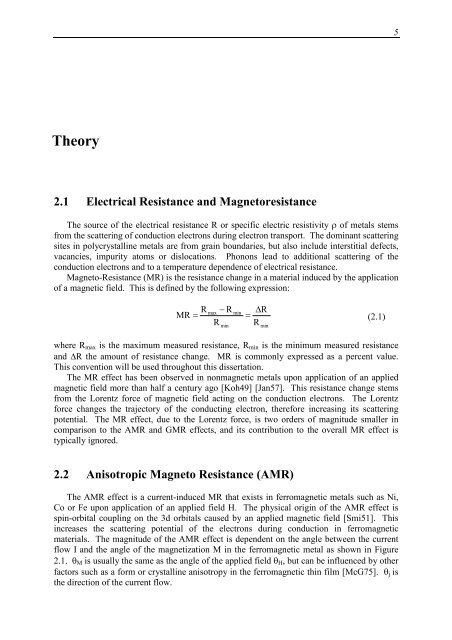Spin Valve Systems for Angle Sensor Applications - tuprints
Spin Valve Systems for Angle Sensor Applications - tuprints
Spin Valve Systems for Angle Sensor Applications - tuprints
Create successful ePaper yourself
Turn your PDF publications into a flip-book with our unique Google optimized e-Paper software.
2Theory<br />
2.1 Electrical Resistance and Magnetoresistance<br />
The source of the electrical resistance R or specific electric resistivity ρ of metals stems<br />
from the scattering of conduction electrons during electron transport. The dominant scattering<br />
sites in polycrystalline metals are from grain boundaries, but also include interstitial defects,<br />
vacancies, impurity atoms or dislocations. Phonons lead to additional scattering of the<br />
conduction electrons and to a temperature dependence of electrical resistance.<br />
Magneto-Resistance (MR) is the resistance change in a material induced by the application<br />
of a magnetic field. This is defined by the following expression:<br />
MR<br />
R<br />
− R<br />
R<br />
max min<br />
= =<br />
(2.1)<br />
min<br />
where Rmax is the maximum measured resistance, Rmin is the minimum measured resistance<br />
and ∆R the amount of resistance change. MR is commonly expressed as a percent value.<br />
This convention will be used throughout this dissertation.<br />
The MR effect has been observed in nonmagnetic metals upon application of an applied<br />
magnetic field more than half a century ago [Koh49] [Jan57]. This resistance change stems<br />
from the Lorentz <strong>for</strong>ce of magnetic field acting on the conduction electrons. The Lorentz<br />
<strong>for</strong>ce changes the trajectory of the conducting electron, there<strong>for</strong>e increasing its scattering<br />
potential. The MR effect, due to the Lorentz <strong>for</strong>ce, is two orders of magnitude smaller in<br />
comparison to the AMR and GMR effects, and its contribution to the overall MR effect is<br />
typically ignored.<br />
∆R<br />
R<br />
2.2 Anisotropic Magneto Resistance (AMR)<br />
The AMR effect is a current-induced MR that exists in ferromagnetic metals such as Ni,<br />
Co or Fe upon application of an applied field H. The physical origin of the AMR effect is<br />
spin-orbital coupling on the 3d orbitals caused by an applied magnetic field [Smi51]. This<br />
increases the scattering potential of the electrons during conduction in ferromagnetic<br />
materials. The magnitude of the AMR effect is dependent on the angle between the current<br />
flow I and the angle of the magnetization M in the ferromagnetic metal as shown in Figure<br />
2.1. θM is usually the same as the angle of the applied field θH, but can be influenced by other<br />
factors such as a <strong>for</strong>m or crystalline anisotropy in the ferromagnetic thin film [McG75]. θj is<br />
the direction of the current flow.<br />
min<br />
5

















